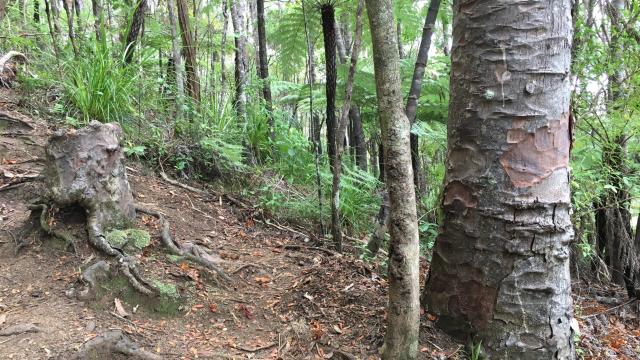A tree stump in New Zealand is very much alive, thanks to an interconnected root system that benefits both the stump and its neighbouring trees. Scientists say this unusual symbiotic arrangement could change our very conception of what it means to be a tree.
We tend to think of trees as individuals, but the roots of some species fuse together to allow the sharing of resources, such as water, carbon, mineral nutrients, and microorganisms.
On some occasions, these elaborate root systems involve a seemingly dead tree stump, an observation first made in the 1830s. Why living trees should expend resources to support leafless cohorts is not fully understood, nor the extent to which resources are shared among living trees and stumps.
New research published today in iScience sheds new light on this peculiar arboreal arrangement, owing to the discovery of a living kauri (Agathis australis) stump in a New Zealand forest.
The authors of the new study, Sebastian Leuzinger and Martin Bader from the Auckland University of Technology, say the discovery points to a previously unknown relationship between living trees and not-so-dead tree stumps. The physiological interactions between living trees and stumps, they write in the study, “may be much more complex than previously assumed.”
Leuzinger and Bader stumbled upon the stump while out for a hike. The woody stub caught their eye because callus tissue could be seen growing over its dead and rotting parts. It was also producing resin, which indicated the presence of living tissue. This prompted a more thorough investigation in which the researchers measured water flowing through the tissues of the stump, and also its rate of respiration, which matched those seen in the surrounding trees.
“We measured water flow with ‘heat-ratio sap flow sensors’,” Leuzinger told Gizmodo. “They detect water movement in tissue by sending out very small heat pulses and measuring how quickly that heat dissipates.”
These measurements indicated that the kauri stump is inactive during the day when living trees transpire. But during the night and on rainy days, the tree stump becomes active, circulating water — and presumably carbon and nutrients — through its tissues. As the authors write in the new study, these results:
…indicate that such symbioses may be much more complex than previously assumed: by physiologically exploiting ‘downtimes’ of transpiring trees during the night or rainy days with high water potentials in the root network living stumps seem to act partially autonomously, strategically tapping into resources rather than simply becoming part of the neighbouring trees’ extended root networks.
On its own, a stump cannot perform these functions. Trees need leaves for gas exchange and photosynthesis, which enables the production of carbohydrates. Without carbohydrates, trees and plants lack the energy and building blocks required for growth. But this leafless kauri tree stump is very much alive, its roots having grafted onto those of its living neighbours.
These grafts happen when a tree detects biocompatible root tissue nearby, enabling “hydraulic coupling.” In this case, the grafts likely formed prior to the stump losing its green foliage, but the researchers aren’t entirely sure.
For the stump, the advantages of this arrangement are obvious — it gets to stay alive despite not being able to produce carbohydrates. But as the authors point out in the study, this arrangement may actually be symbiotic in nature.
Joined together, for example, the living trees have enhanced access to resources like water and nutrients. This setup also increases the stability of the trees on the steep forest slope, with the firm, healthy roots working to prevent erosion. On the downside, these root connections might facilitate the spread of disease, namely kauri dieback (Phytophthora agathidicida).
All this said, the “exact mechanisms and the evolutionary benefit of this can only be speculated on at this stage,” said Leuzinger. More work is required, as the authors themselves admit in the study:
Clearly, only having observed a single living kauri tree stump prevents us from drawing broader conclusions. Although we personally have not yet seen a second occurrence of a living stump belonging to this iconic New Zealand species, from talking to local foresters, we know that this phenomenon has apparently been noticed in the past and the formation of natural root grafts in kauri was already suspected 80 years ago.
The researchers say this surprisingly complex interplay between living trees and stumps could change our perception of trees.
“If lateral water transport between trees proves to be a common phenomenon, we have to rethink our definition of a ‘tree’,” said Leuzinger. “In fact, we may be looking at the forests as superorganisms that redistribute water between genetically different individuals.”
So the old saying about not being able to see the forest for the trees is only partially correct. Scientists haven’t been able to see the forest for the trees and the tree stumps, as this new research wonderfully illustrates.
